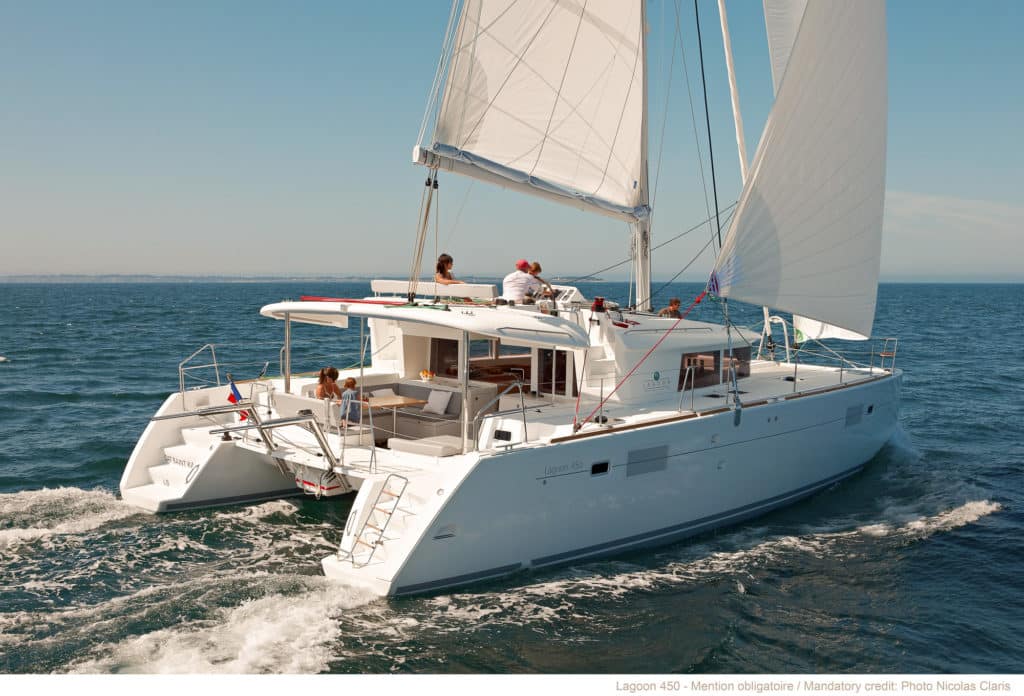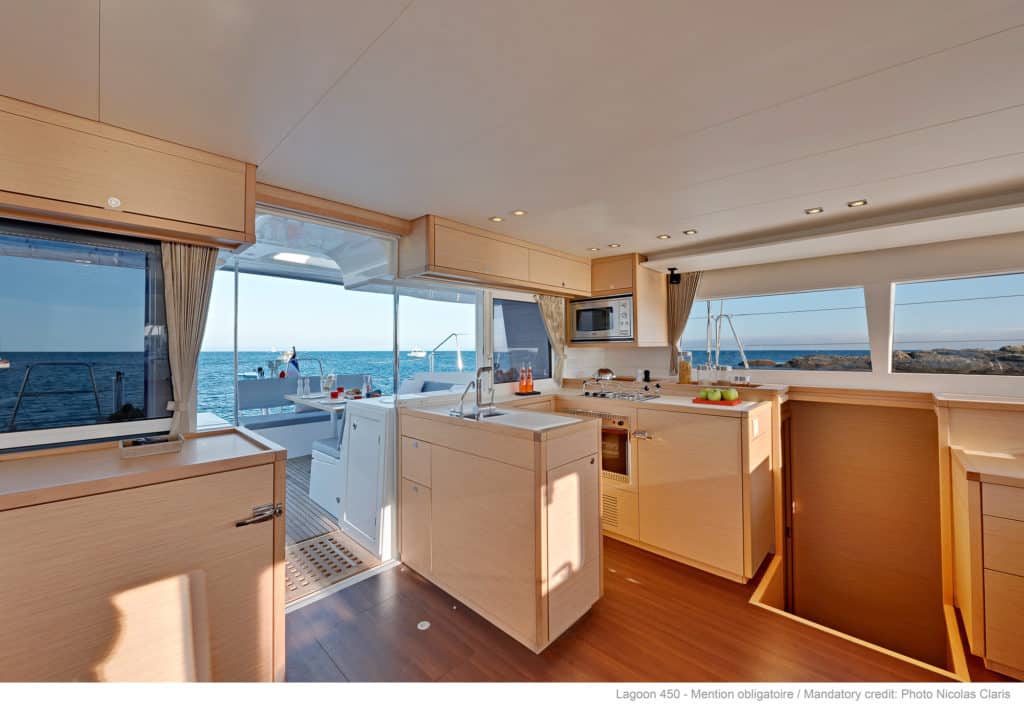
You’d have to imagine that the builders and designers of Lagoon Catamarans thought long and hard before making the commitment to replace their highly successful Lagoon 440—they sold more than 400 of the popular cats in a five-year production run—with a new, slightly larger model, the Lagoon 450. After all, the 440 had been well received both critically and in the marketplace, and it’s always challenging and risky to tinker with a proven entity. But through owner feedback and their own intuition and experience, they identified several items that they believed could be improved upon and/or refined. Some were rather major; others were quite subtle. Ultimately, they concluded that they could indeed create a bigger, safer 45-footer that was also more comfortable and luxurious.
And as we discovered last fall during the introduction and a test sail of the Lagoon 450 at the U.S. Sailboat Show in Annapolis, Maryland, they have pretty much succeeded on each count.
There are several features from the 440 that the Lagoon design team of Marc Van Peteghem and Vincent Lauriot Prévost (VPLP) considered irreplaceable, namely the boat’s fine performance under sail (which we’ll address momentarily) and the signature flybridge around which the entire deck layout was centered. The redesigned flybridge on the 450, then, retains its predecessor’s intent but is improved in its new iteration. On the 440, to gain access to the stairwell that led to the second tier, one had to first leave the cockpit and go out on deck. Now, via sets of stairs incorporated directly into the cockpit to port and starboard, you can easily stroll up to the bridge—with its steering station, engine controls, sheets and related running rigging, and a new, dedicated sunbathing lounge directly forward on the upper deck—in seconds flat. It’s not only a better use of space, but from a safety standpoint, it’s also a significant upgrade.
In one of the subtle improvements, the cockpit itself has been rearranged, with a new wraparound settee and dining table to port and an inviting “lazy-boy couch” to starboard, that significantly opens up the floor plan. There’s also an ingenious and nifty overhead opening hatch in the hard dodger that can provide ventilation and sunshine in good weather and protection from the elements under inclement conditions.
Forward of the distinctive Lagoon cabin house, sporting the rounded corners and big windows that characterize the entire brand, there’s a second cockpit/lounge area with a pair of huge seat lockers, one of which is perfectly sized for the optional 11-kilowatt Onan generator, a feature we’d guess most owners will choose, though a trio of 135-watt solar panels is yet another useful add-on to satisfy electricity demands.
That aforementioned aft cockpit, specifically the dining area to port, is situated directly abaft the large, U-shaped galley in the main saloon, which has its own dedicated sliding window behind the sink. In fact, when the sliding cockpit doors are opened as well, there’s virtually no separation between the interior saloon and the exterior living area—it’s one big, open space, and perfect for parties and open-air living. My one and only real complaint about the 450 is that the corners of the galley’s overhead lockers are very sharp and just above eye level for a 6-footer like me, and at one point, I almost gave myself a good knock stepping into the saloon from the cockpit.

The ultra-contemporary accommodations and furnishings have been fashioned by the Italian interior specialists Nauta Yachts. The overall design maximizes space and adds lots of intriguing little touches: indirect lighting, a hideaway cabinet for the flat-screen TV, clever catches for the drawers and lockers, and a washing machine with a crafty adjoining hamper, among others. The model I inspected, hull number two, was finished in light oak and walnut and was absolutely stunning. Facing forward, a dining area with an L-shaped settee and a pair of “floating” seats is to starboard, and the navigation station, with full electronics and an optional second steering station, is to port.
On the 450, to maximize interior volume, the hulls are slightly larger than the 440’s. Our test boat was laid out in the three-cabin/three-head owner’s version (a four-cabin/four-head model is also available) in which the main stateroom, which spans the entire starboard ama, is essentially a dedicated apartment that can be closed off from the rest of the yacht for privacy. It’s complete with a huge aft berth, a small office, a large en suite head with separate shower compartment (as have all the heads), and oodles of closet and storage space. A Lagoon representative said about 60 percent to 65 percent of new owners choose this arrangement, and it’s easy to understand why.
We tested the boat on Chesapeake Bay twice; we were skunked for breeze the first time, so we came back the next day when the wind had filled in at 10 to 12 knots. I’m glad we did. With its tall, 75-foot, double-spreader rig and square-topped mainsail, the 450 had abundant power and trucked to weather, when sailing closehauled under the genoa, at better than 6 knots. Once we cracked off and furled the genoa, replacing it with a code zero-type gennaker set on a dedicated sprit off the forward crossbeam, the boat knocked off 8-plus knots at an apparent-wind angle of 60 degrees.
The mainsheet and traveler are aft of the helmsman; the sheets and reefing lines are forward; everything is set up efficiently with electric winches and rope clutches. Though the choreography is a bit challenging the first time one tries to do everything alone—furl the genoa, unfurl the gennaker, trim the main—once you get the hang of it, the 450, which is by no means a small boat, is very easy to sail solo. And the view from the flybridge is expansive and terrific.
So yes, I’m sure it was tempting for everyone at Lagoon to look at the 440 and think, “Let’s leave well enough alone.” Future owners of the Lagoon 450, however, will be very glad that the company’s visionaries chose the opposite tack.
Herb McCormick is CW’s senior editor.
See more photos of the Lagoon 450 here.
LOA: 45’10”
LWL: 43’11”
Beam: 25’9″
Draft: 4’3″
Sail Area: 1,442 sq.ft.
Displacement (light): 25,799 lb.
Displacement (loaded): 47,408 lb.
D/L: 248
SA/D: 17.6
Water: 92 gal.
Fuel: 264 gal.
Holding (per head): 21 gal.
Mast Height: 75’8″
Engines: Twin 40- or 55-hp. diesels
Designer: Van Peteghem Lauriot Prevost (VPLP)
Interior: Nauta Yachts
Price: $530,000








